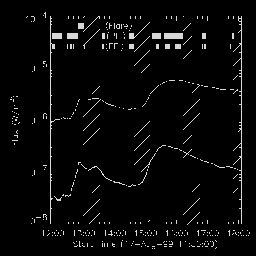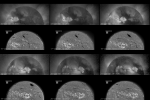
In this Nugget I present some material on a CME I have just started to study, so it will be a while before one can be certain about what was going on. The CME occurred on 17 August 1999, a day before the Whole Sun Month 3 campaign officially started. The following figure (click to enlarge) shows the GOES soft X-ray light curves and SXT data coverage.

Apparently two flares occurred in the plotted time range. Both of them were from AR 8668 (then in the NE quadrant). The first event was well captured by SXT. The SXT flare sequence shows northeastern motions outside the brightest loops.
The first movie (click the thumbnail) accommodates various images of AR 8668 in a six-hour period that includes the two flares. They are soft X-ray (SXT), EUV (TRACE and EIT) and optical (SOON H-alpha) images. Be warned that this movie is huge (20 MB in Java), and that coalignment needs some more work. The SXT images are presented in negative. I first made equally spaced (every 3 minutes) time grids and picked up the images closest in time to each grid. No update of images means a data gap, which is most serious for SXT. One can do a great job on flares with high-cadence SXT data, but the cadence on a longer time scale is very irregular as a result of spacecraft night, the limited capacity of the data recorder combined with the limited opportunities of data downlink.

This movie is very informative, but it is not easy to fully describe it at the moment. One should keep an eye on the time sequence of the appearances of bright and dark features. In both flares, motion or activation of dark features seems to precede brightenings.
Although the dynamic changes of the region (especially in the TRACE movie) are certainly worthy of further analysis, I should point out that larger-scale structures than the full extent of AR 8668 were involved in the CME. The following movie (click the thumbnail) shows it. This is a movie of SXT full disk images (upper part only) in negative. The vertical spikes show saturation due to bright X-ray emission from AR 8668 and the region on the SW limb.

From this movie, AR 8668 had a loop system sticking out to the east or southeast, but more prominent disturbances seem to have gone to the north, restructuring a large area. Based on previous data, we know that the changes in the area to the north of AR 8668, as seen in SXT images, are characteristic of a filament eruption. A similar movie of EIT images is given below (click the thumbnail).

Although a filamentary structure is not clearly seen, the area north of AR 8668 seems
to have been disturbed already around the time of the first flare. The following
movie of H images
(click the thumbnail) show that a filament was broken by 14:36 UT and disappeared
between 15:06 UT and 15:36 UT.
images
(click the thumbnail) show that a filament was broken by 14:36 UT and disappeared
between 15:06 UT and 15:36 UT.

Interestingly, the disappearance of the filament outside AR 8668 may be correlated with the appearance of a fast CME in LASCO C2 images. The figure shows that the CME was first seen without a so-called frontal loop (13:54 UT), and that one has to wait until 15:08 UT to see it. The frontal loop is quite fast, i.e., 950 km/s between 16:30 and 16:54 UT, on the basis of the height-time plot.
Lastly, this region sustained its S or inverse-S appearance (sigmoid or nuoid) in
SXT images over the next few days. See the following figure (click to enlarge).
This figure also shows
H images from
Big Bear Solar Observatory.
images from
Big Bear Solar Observatory.

Despite the usual assertion of the possible correlation between such an appearance and CMEs, the eruptive activity almost ceased after the CME presented here. One can call the region in later days a ``tired sigmoid''. It would be important to study the magnetic field evolution of the region to understand what makes lively and tired sigmoids.
We are still in a stage that may be another example of solar dermatology (probably meaning excruciatingly detailed description of not so important phenomena?). But I would like to close by pointing out that the direct cause for the fast CME may have been the filament away from the active region being erupted and that the dynamics within the active region (including the flares) may have participated in destabilizing larger-scale structures. The remote filament may have been part of a long filament channel that passed the eastern part of the active region.